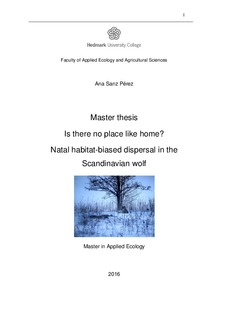| dc.description.abstract | Natal dispersal is an important mechanism for the viability of populations, as individuals should target the habitat where fitness will be higher. Dispersal theory has suggested that influence of local conditions on individual phenotypes, or experience gained in the natal habitat, could improve future performance if individuals disperse towards a habitat similar to their natal habitat type (i.e, Natal habitat-biased dispersal). Although this phenomenon has been proved for several taxa, little is known about the existence of this effect on large carnivores. In this study, I tested whether the Scandinavian wolf was influenced by the habitat characteristics of its natal territory when choosing a new territory to establish. I used natal and established territories of Scandinavian wolves during the period 1998/1999-2011/2012, and I accounted for potential available habitats for each dispersing individual by simulating dispersing trajectories based on movement behavior characteristics from 13 GPS-collared wolves in Scandinavia. I used several environmental variables to characterize wolf territories. I divided natal, established and available territories with similar habitat charasteristics in clusters by using K-means clustering methods, and tested statistically whether individuals selected the natal habitat type by using conditional logistic regression. Dispersers did not establish in habitats with similar characteristics to those of the natal territory. Groups of territories with similar habitat characteristics were placed in different parts of Scandinavia, so enough habitat heterogeneity was present to expect any type of habitat selection. Although I did not find any clear pattern of habitat selection, wolves avoided areas characterized by high antropogenic disturbance. A combination of wolf intra-species characteristics and its occurrence on the Scandinavian human-dominated landscape could explain the lack of influence of the natal habitat characteristics in the choice of the established territory. Further research on the role the interactions between natal experience, individual heterogeneity and human activities play on dispersal outcomes is needed to understand the mechanisms that drive dispersal choices in large carnivores. | nb_NO |
